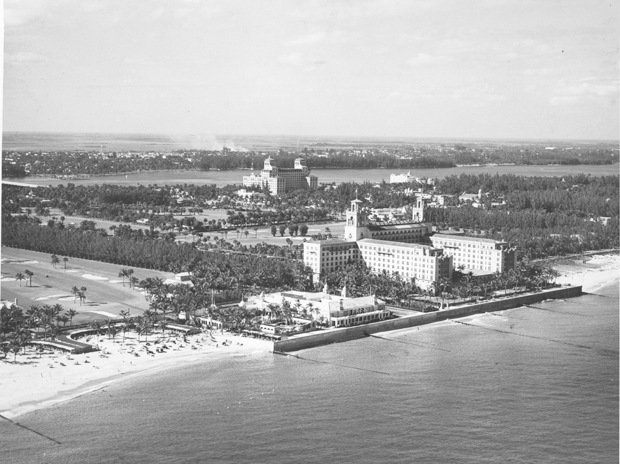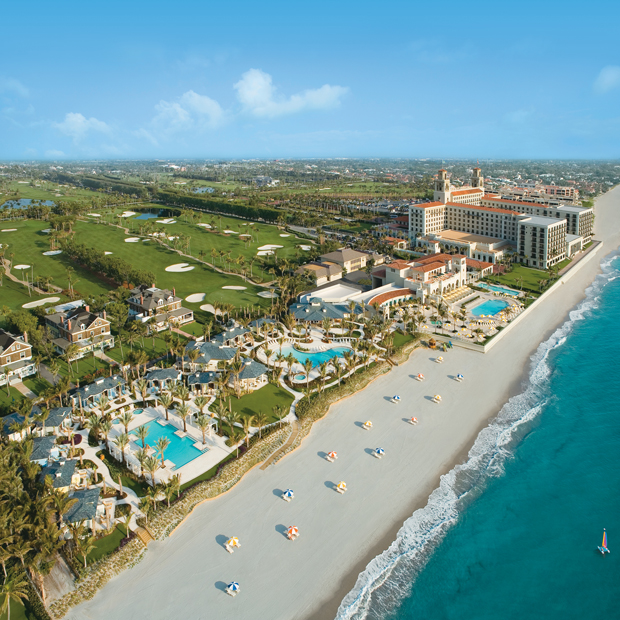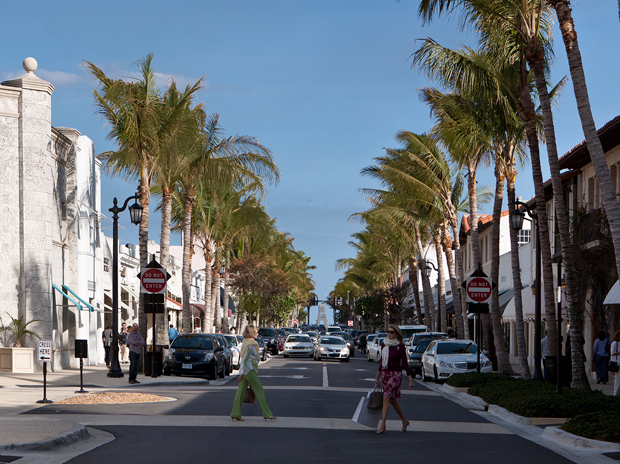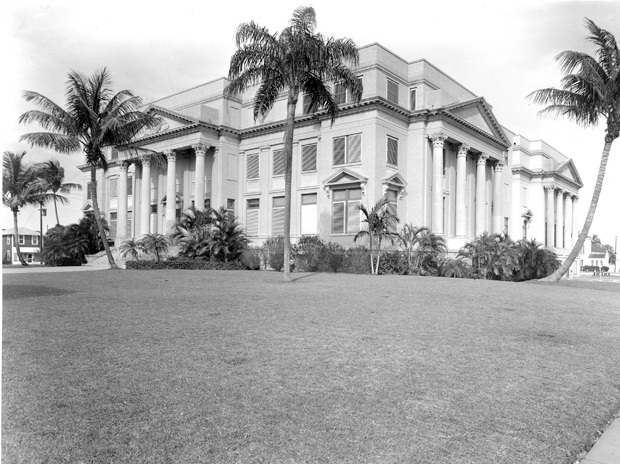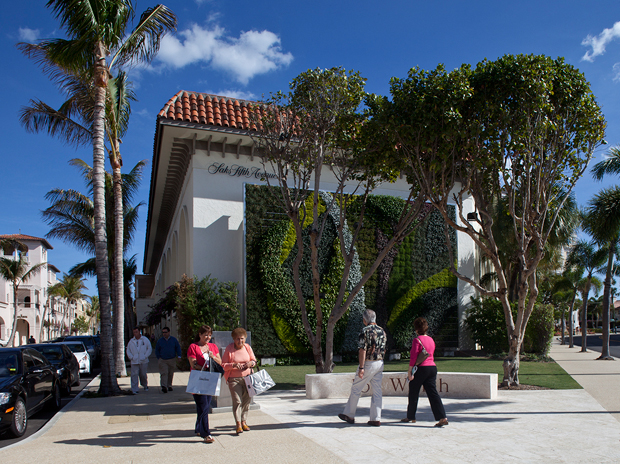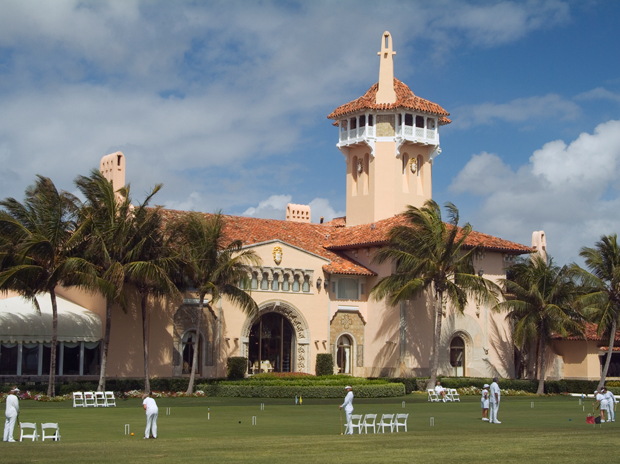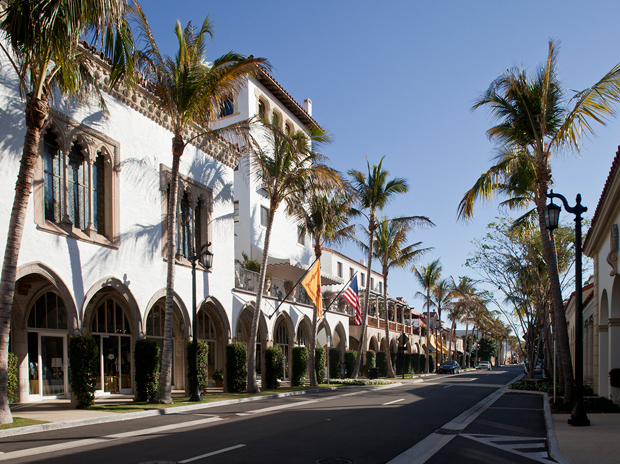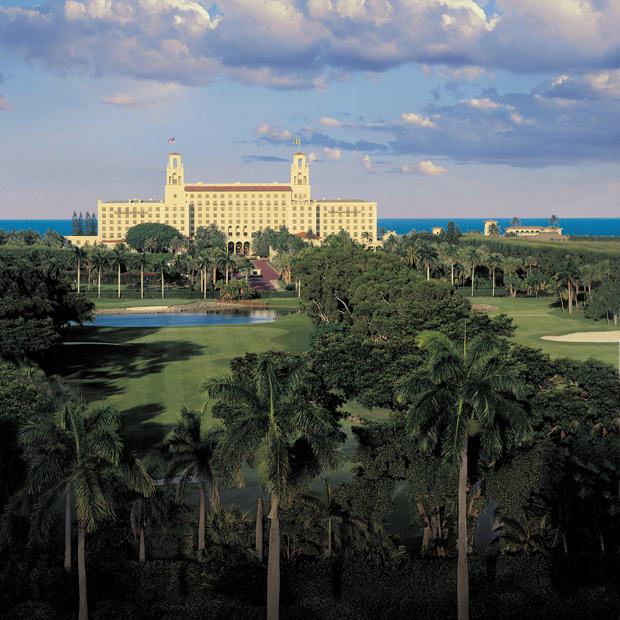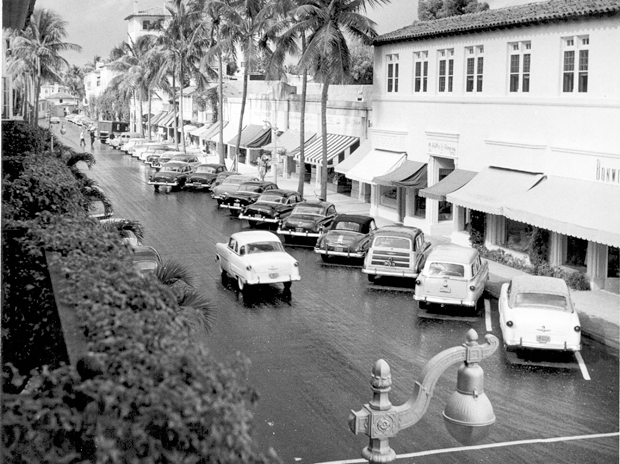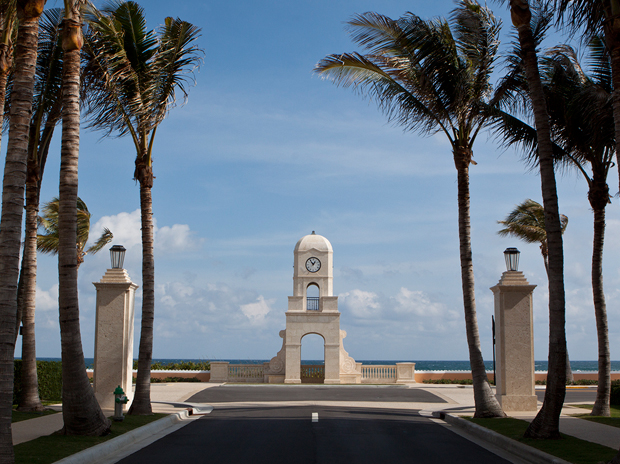Palm Beach is itself an island - a geographical peculiarity known as a barrier island, a land mass running parallel to the mainland, sometimes for miles, whose cause is still uncertain. It is connected to the rest of Florida by the Florida East Coast Railroad, a symbol of the American industrial miracle, which was built by the founding father of this staggeringly wealthy resort city. Palm Beach has powerful parallels with American society and the history of the nation, both of which have been shaped and presided over by its illustrious residents.
Palm Beach, this community - a microcosm of that grander society which it parallels on so many levels, celebrates its one hundredth anniversary this April 17. For a century it has been a home from home for some of the most wealthy and influential dynasties in the history of Twentieth Century America, such as the Whitneys, the Vanderbilts, the Rockefellers and the Kennedys. It is a birthday laden with symbolism of glories past and the glittering future that lies ahead.
From the Duke and Duchess of Windsor to John F. Kennedy, Tony Bennett, John Lennon, and Rod Stewart, Palm Beach’s status of utterly refined pedigree has been attracting the world’s elite, socialites and celebrities, Old Money and heads of state to its sun-baked sub-tropical shores since its inception.
Conceived by visionary Henry Morrison Flagler, founder of Standard Oil, at the turn of the nineteenth century, Palm Beach almost immediately became the winter destination of choice for America’s social and cultural elite due to the year round Florida sun and the sheer luxury of the stunning resort hotels he built. The Royal Poinciana Hotel and The Breakers Hotel became bywords for the kind of lifestyle about which ordinary Americans could only dream, and the former ultimately became the world’s largest hotel.
The Breakers was originally named the Palm Beach Inn and located on beachfront section of the Royal Poinciana. This Florida icon took its name from the breaking Atlantic waves that would lull guests into slumber and which they requested with increasing frequency. At one time, it played host to the four major charity balls held annually on the island - Heart Ball, Red Cross Ball, Cancer Ball, and Hospital Ball. These were extravagant events attended by Hollywood royalty such as Cary Grant and Gary Cooper, and were matched in wealth, stature, fame and glamour by the hotel’s own list of regular guests.
Significantly, it was this irresistible climatic clemency that brought Palm Beach’s second father to its shores. While Flagler brought the both people and money, and most tellingly people with money, to the island, it was Addison Mizner who brought a truly unmistakable sense of Palm Beach style. Having originally visited the area for health reasons, Mizner - already a highly successful New York architect - soon set to work on the aesthetic identity of this emerging city.
What resulted from this was an instantly recognizable and eternally imitated style that skips across continents and history in one single building - taking in classic Mediterranean and Moor influenced Spanish architecture, famously using twenty two different kinds of window treatments for the north façade of his iconic Everglades Club. His signature predilection for courtyards, balconies and windows, was no whim, however, it was rather his skillfully tasteful solution to the at times powerful Florida heat - as each of these features harnessed the cooling properties of the sea breezes.
Mizner’s first project, the oceanfront El Mirasol, which he built for high-financier Edward T. Stotesbury and his wife Eva, came to define the Palm Beach style. He moved on to other highly significant and influential commissions including Via Mizner and houses he built for other East Coast magnates.
A vacation was always time when a working man, be he a steelworker or a steel magnate, would spend with his family, and as such the wife and mother’s role was especially significant. This dynamic was to prove particularly influential in the development of Palm Beach. It was the society ladies, those who would be hosting glamorous star-studded parties, who often exerted the greatest influence on Mizner and his successors’ designs.
Perhaps the most luminous example of this was the extraordinary Mar-a-Lago estate, which was constructed by wealthy Edward F. Hutton at the behest of his wife Marjorie Merriweather Post and means “sea to lake” in Latin after her lengthy searches for the perfect location. She oversaw every last exquisite detail, including over 2,000 square feet of black and white marble taken from a Cuban castle.
Placed on the National Register of Historic Places by Congress in 1969, such was Mar-a-Lago’s beautiful opulence. Featuring a tower affording views of the mistress of the house surveyed, three cargoes of rare Dorian stone from Italy, and the breathtaking luxury of the 36,000 classic Spanish tiles used throughout the estate - a life’s work of a collector dating back to the late 1800s and featuring some examples dating back to the 15th century.
Considered the most valuable piece of real estate in even this most inflated of markets, the estate was purchased by Donald Trump in 1985 and converted into one of the world’s most exclusive luxury lifestyle clubs, the Mar-a-Lago Club, described as the “Jewel of Palm Beach”.
As well, The Colony, The Brazilian Court, and The Biltmore have been hosts of some of the most glamorous and lavish reunions and parties thrown last century. Beautiful clientele have chosen these Palm Beach hotels to keep their mind away from their busy lives and agendas.
Palm Beach’s history is littered with grande dames, such as wife of carpet magnate Stephen Sanford and “Queen of Palm Beach”, Mary Sanford who set the island’s social scene alight along with her close friend Rose Kennedy, starring at countless glittering charity balls at the Poinciana Club amongst others.
The class of people who were Palm Beach regulars were defined by their taste for the finer, or even finest, things in life and their ability to afford them. These were the same class of people who, with their vast economic power and influence, were almost uniquely placed to meet the incredibly high demands of such a market. Thus, the international luxury retail phenomena Worth Avenue was born. For almost all of Palm Beach’s century in operation, Worth Avenue has been one of the prime luxury retail locations, and destinations, in the world.
Visitors stroll the pavements of its four blocks and Mizner’s myriad intriguing vias and courtyards, perusing the finest couture houses, jewelers, art and antique dealers, and spa services. Besides Van Cleef & Arpels, Jimmy Choo, Chanel and Hermès, Worth Avenue cognoscenti also now have a new facet of Worth Avenue to explore; 150 Worth is a two-story Mediterranean-style shopping enclave just steps from the Atlantic Ocean. It is home to Saks Fifth Avenue and more than twenty exclusive boutiques featuring the finest European and domestic fashions and jewelry such as Louis Vuitton, Gucci and Christofle.
While taking refreshment in the some of the best restaurants and cafes in the region - chefs as renowned as Daniel Boulud and Masaharu Morimoto have restaurants in the area - visitors luxuriate in the knowledge that the azure depths of the Lake Worth and Atlantic Gulf Stream are always a mere stroll away.
There is a remarkably intimate quality to the places chosen and constructed by society’s elite in which to spend their winters - known as “the little season”. Often they are communities, albeit ultra luxury ones, that recreate the sense of neighborhood and of as much as an atmosphere of cohesive integration as is possible, bearing in mind the extraordinary wealth involved, that their inhabitants lack in the metropolitan palaces of their real lives.
Incredibly, given the cumulative billions of dollars that reside in and has been invested in this fabulous resort island since its inception, it still retains a sense of close knit community. Organizations such as the Chamber of Commerce, Worth Avenue Association and the Garden Club maintained, and still do to this day, the island’s elite standards, prestige business environment and stunning natural beauty and have counted among their members such formidable and glamorous defenders as Mrs. John Phipps and Mrs. Henry Phipps, Mrs. Frederick E. Guest and Mrs. Edward T. Stotesbury.
Palm Beach is in many ways America’s village of the rich and famous as much as its playground. In a one hundred year statement of epic relaxation and extravagant expression, it represents the narrow social nexus point of the all wealth and glamour that America produced in its most illustrious century and stands to usher in the new waves of the grand generations to come.
- Ben Stewart
Palm Beach/ Worth Avenue
Address: Palm Beach, 33480
Website: www.palmbeachfl.com
www.worth-avenue.com
Photo Credit: Historic Images: Courtesy of Hayworth Creative Public Relations
Worth Avenue: Worth Avenue Association, Inc.
The Breakers
Address: One South County Road
Palm Beach, 33480
Tel: 561 655 6611 Reserve Online
Website: www.thebreakers.com
Photo Credit: Courtesy of The Breakers Palm Beach
The Mar-a-Lago Club
Address: 1100 South Ocean Boulevard
Palm Beach, 33480
Tel: 561 832 2600
Website: www.maralagoclub.com
Photo Credit: Courtesy of The Trump Organization
Palm Beach, this community - a microcosm of that grander society which it parallels on so many levels, celebrates its one hundredth anniversary this April 17. For a century it has been a home from home for some of the most wealthy and influential dynasties in the history of Twentieth Century America, such as the Whitneys, the Vanderbilts, the Rockefellers and the Kennedys. It is a birthday laden with symbolism of glories past and the glittering future that lies ahead.
From the Duke and Duchess of Windsor to John F. Kennedy, Tony Bennett, John Lennon, and Rod Stewart, Palm Beach’s status of utterly refined pedigree has been attracting the world’s elite, socialites and celebrities, Old Money and heads of state to its sun-baked sub-tropical shores since its inception.
Conceived by visionary Henry Morrison Flagler, founder of Standard Oil, at the turn of the nineteenth century, Palm Beach almost immediately became the winter destination of choice for America’s social and cultural elite due to the year round Florida sun and the sheer luxury of the stunning resort hotels he built. The Royal Poinciana Hotel and The Breakers Hotel became bywords for the kind of lifestyle about which ordinary Americans could only dream, and the former ultimately became the world’s largest hotel.
The Breakers was originally named the Palm Beach Inn and located on beachfront section of the Royal Poinciana. This Florida icon took its name from the breaking Atlantic waves that would lull guests into slumber and which they requested with increasing frequency. At one time, it played host to the four major charity balls held annually on the island - Heart Ball, Red Cross Ball, Cancer Ball, and Hospital Ball. These were extravagant events attended by Hollywood royalty such as Cary Grant and Gary Cooper, and were matched in wealth, stature, fame and glamour by the hotel’s own list of regular guests.
Significantly, it was this irresistible climatic clemency that brought Palm Beach’s second father to its shores. While Flagler brought the both people and money, and most tellingly people with money, to the island, it was Addison Mizner who brought a truly unmistakable sense of Palm Beach style. Having originally visited the area for health reasons, Mizner - already a highly successful New York architect - soon set to work on the aesthetic identity of this emerging city.
What resulted from this was an instantly recognizable and eternally imitated style that skips across continents and history in one single building - taking in classic Mediterranean and Moor influenced Spanish architecture, famously using twenty two different kinds of window treatments for the north façade of his iconic Everglades Club. His signature predilection for courtyards, balconies and windows, was no whim, however, it was rather his skillfully tasteful solution to the at times powerful Florida heat - as each of these features harnessed the cooling properties of the sea breezes.
Mizner’s first project, the oceanfront El Mirasol, which he built for high-financier Edward T. Stotesbury and his wife Eva, came to define the Palm Beach style. He moved on to other highly significant and influential commissions including Via Mizner and houses he built for other East Coast magnates.
A vacation was always time when a working man, be he a steelworker or a steel magnate, would spend with his family, and as such the wife and mother’s role was especially significant. This dynamic was to prove particularly influential in the development of Palm Beach. It was the society ladies, those who would be hosting glamorous star-studded parties, who often exerted the greatest influence on Mizner and his successors’ designs.
Perhaps the most luminous example of this was the extraordinary Mar-a-Lago estate, which was constructed by wealthy Edward F. Hutton at the behest of his wife Marjorie Merriweather Post and means “sea to lake” in Latin after her lengthy searches for the perfect location. She oversaw every last exquisite detail, including over 2,000 square feet of black and white marble taken from a Cuban castle.
Placed on the National Register of Historic Places by Congress in 1969, such was Mar-a-Lago’s beautiful opulence. Featuring a tower affording views of the mistress of the house surveyed, three cargoes of rare Dorian stone from Italy, and the breathtaking luxury of the 36,000 classic Spanish tiles used throughout the estate - a life’s work of a collector dating back to the late 1800s and featuring some examples dating back to the 15th century.
Considered the most valuable piece of real estate in even this most inflated of markets, the estate was purchased by Donald Trump in 1985 and converted into one of the world’s most exclusive luxury lifestyle clubs, the Mar-a-Lago Club, described as the “Jewel of Palm Beach”.
As well, The Colony, The Brazilian Court, and The Biltmore have been hosts of some of the most glamorous and lavish reunions and parties thrown last century. Beautiful clientele have chosen these Palm Beach hotels to keep their mind away from their busy lives and agendas.
Palm Beach’s history is littered with grande dames, such as wife of carpet magnate Stephen Sanford and “Queen of Palm Beach”, Mary Sanford who set the island’s social scene alight along with her close friend Rose Kennedy, starring at countless glittering charity balls at the Poinciana Club amongst others.
The class of people who were Palm Beach regulars were defined by their taste for the finer, or even finest, things in life and their ability to afford them. These were the same class of people who, with their vast economic power and influence, were almost uniquely placed to meet the incredibly high demands of such a market. Thus, the international luxury retail phenomena Worth Avenue was born. For almost all of Palm Beach’s century in operation, Worth Avenue has been one of the prime luxury retail locations, and destinations, in the world.
Visitors stroll the pavements of its four blocks and Mizner’s myriad intriguing vias and courtyards, perusing the finest couture houses, jewelers, art and antique dealers, and spa services. Besides Van Cleef & Arpels, Jimmy Choo, Chanel and Hermès, Worth Avenue cognoscenti also now have a new facet of Worth Avenue to explore; 150 Worth is a two-story Mediterranean-style shopping enclave just steps from the Atlantic Ocean. It is home to Saks Fifth Avenue and more than twenty exclusive boutiques featuring the finest European and domestic fashions and jewelry such as Louis Vuitton, Gucci and Christofle.
While taking refreshment in the some of the best restaurants and cafes in the region - chefs as renowned as Daniel Boulud and Masaharu Morimoto have restaurants in the area - visitors luxuriate in the knowledge that the azure depths of the Lake Worth and Atlantic Gulf Stream are always a mere stroll away.
There is a remarkably intimate quality to the places chosen and constructed by society’s elite in which to spend their winters - known as “the little season”. Often they are communities, albeit ultra luxury ones, that recreate the sense of neighborhood and of as much as an atmosphere of cohesive integration as is possible, bearing in mind the extraordinary wealth involved, that their inhabitants lack in the metropolitan palaces of their real lives.
Incredibly, given the cumulative billions of dollars that reside in and has been invested in this fabulous resort island since its inception, it still retains a sense of close knit community. Organizations such as the Chamber of Commerce, Worth Avenue Association and the Garden Club maintained, and still do to this day, the island’s elite standards, prestige business environment and stunning natural beauty and have counted among their members such formidable and glamorous defenders as Mrs. John Phipps and Mrs. Henry Phipps, Mrs. Frederick E. Guest and Mrs. Edward T. Stotesbury.
Palm Beach is in many ways America’s village of the rich and famous as much as its playground. In a one hundred year statement of epic relaxation and extravagant expression, it represents the narrow social nexus point of the all wealth and glamour that America produced in its most illustrious century and stands to usher in the new waves of the grand generations to come.
- Ben Stewart
Palm Beach/ Worth Avenue
Address: Palm Beach, 33480
Website: www.palmbeachfl.com
www.worth-avenue.com
Photo Credit: Historic Images: Courtesy of Hayworth Creative Public Relations
Worth Avenue: Worth Avenue Association, Inc.
The Breakers
Address: One South County Road
Palm Beach, 33480
Tel: 561 655 6611 Reserve Online
Website: www.thebreakers.com
Photo Credit: Courtesy of The Breakers Palm Beach
The Mar-a-Lago Club
Address: 1100 South Ocean Boulevard
Palm Beach, 33480
Tel: 561 832 2600
Website: www.maralagoclub.com
Photo Credit: Courtesy of The Trump Organization
Palm Beach/ Worth Avenue,






